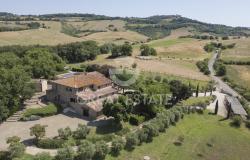Some of the finest masterpieces of Etruscan art are returning to Italy from Russia's Hermitage museum for a show starting next month in the heartland of the ancient civilisation.
The 30 pieces include the only Etruscan bronze funerary urn ever found.
The 4th-century BC piece, found near Perugia in 1842, shows a magnificent decoration of a beautiful, proud youth reclining on an Etruscan drinking couch or 'kline'.
''This is an exciting show and the Hermitage is proud to give Italians a chance to see these magnificent pieces,'' said Anna Trofimova, head of the Hermitage's antiquities collections.
Trofimova selected the pieces with experts from the Etruscan Academy Museum (MAEC) in the southern Tuscan town of Cortona.
The urn and many of its companion pieces were bought by Tsar Alexander II in 1861.
'Etruscan Masterpieces from the Hermitage' runs at the MAEC from September 7 to January 6, 2009.
The MAEC is opening seven new rooms for the occasion and also starting a major new archaeological project with the Hermitage Foundation Italy to uncover more of the ancient glory dotted around the city.
The Cortona museum boasts one of Italy's most interesting Etruscan collections including one of the longest inscriptions in Etruscan, which is still largely undeciphered.
A recent study suggested it might have been an early form of Hungarian.
The Etruscans are believed to have formed the first advanced civilisation in Italy, based in an area called Etruria, corresponding largely to present-day Tuscany, Umbria and northern Lazio.
By the sixth century BC they had become the dominant force in central Italy, but repeated attacks from Gauls and Syracusans later forced them into an alliance with the embryonic Roman state, which gradually absorbed Etruscan civilization.
Although the Etruscans had the upper hand in the early days and supplied Rome with the last three of its first seven kings including the famous Tarquinius Superbus (Tarquin the Proud), the archaeological record of their once sweeping presence in central Italy is scanty compared with that of other civilisations.
Some historians have posited that the Romans actively tried to wipe out the traces of their predecessors, whose sensual and fun-loving approach to life contrasted with the spartan, austere and rigidly patriarchal life of the early Roman republic.
Most of what we know about their civilisation is based on archaeological finds, given the problems in unlocking the secrets of their language.










